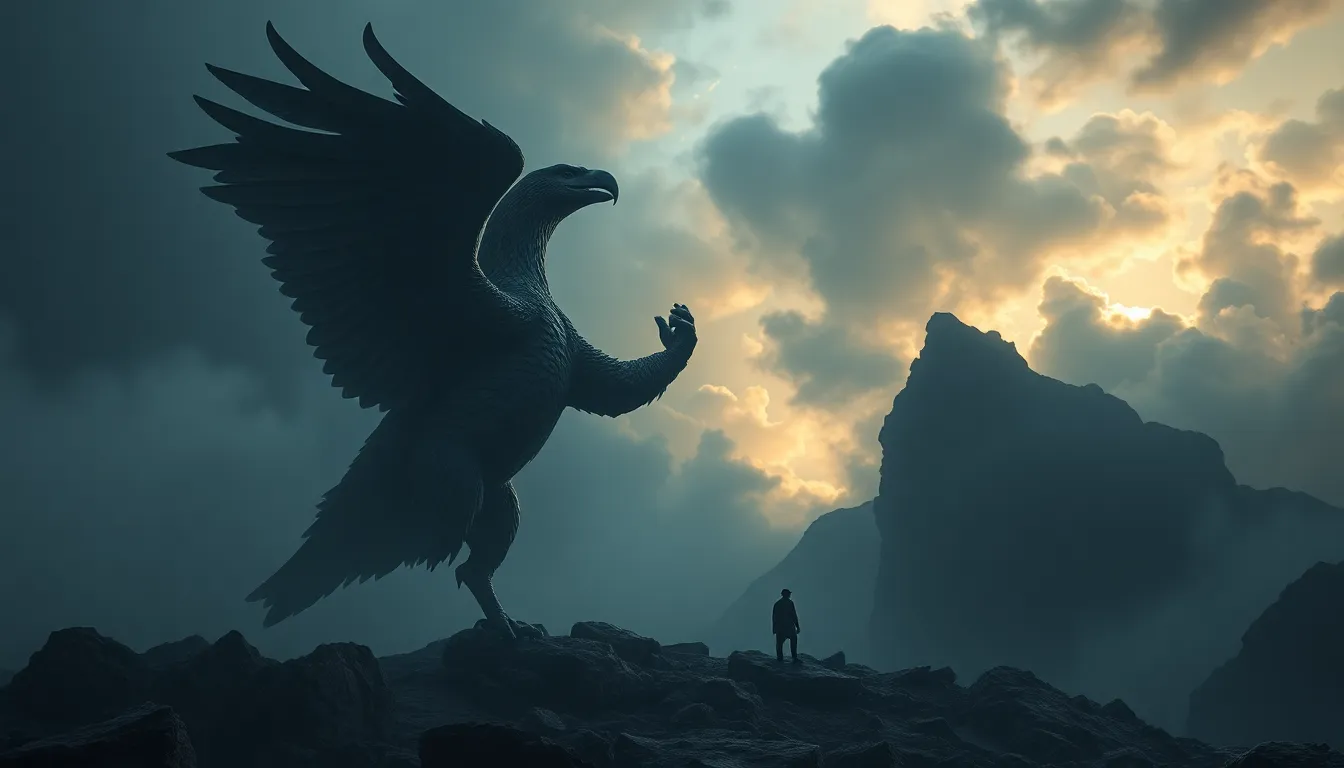The Roc as a Metaphor for the Power of the Gods in Greek Literature
I. Introduction
The Roc, a mythical bird of enormous size, has captured the imagination of people throughout history. Although it originates primarily from Middle Eastern folklore, its symbolism and themes have found a place in various literary traditions, including Greek literature. In this article, we will explore the Roc as a powerful metaphor for divine strength and intervention, shedding light on its significance within the context of mythological narratives.
In Greek literature, the Roc represents not only the sheer power of the gods but also their unpredictable nature. This article aims to delve into the various dimensions of the Roc as a symbol of divine power and its implications in human experiences and literary texts.
II. The Mythological Origins of the Roc
The Roc is often associated with the legendary tales from the Arabian Nights, where it is described as a giant bird capable of carrying off elephants. Its mythological origins can be traced back to ancient texts and folklore, which portray the creature as a symbol of immense power and authority.
A. Historical references and sources
While the Roc is not a native Greek mythological creature, its influence permeates various cultures. The earliest references to the Roc can be found in the works of writers like Marco Polo and in the tales of Sinbad the Sailor. These texts highlight the Roc’s formidable nature, which resonates with the themes of power found in Greek mythology.
B. Comparison with other mythological creatures
When compared to other mythological creatures, such as the Griffin or the Phoenix, the Roc stands out due to its size and dominance in the skies. While the Griffin symbolizes a combination of strength and wisdom, the Roc embodies raw power and the ability to control the elements, making it a fitting metaphor for divine authority.
C. Cultural significance of the Roc in ancient societies
In many ancient societies, the Roc represented not only physical strength but also the power of the gods to shape the world. Its representation in art and literature served as a reminder of the gods’ might and the humans’ place beneath them in the cosmic hierarchy.
III. The Roc as a Symbol of Divine Strength
Throughout ancient texts, the Roc has been depicted in various ways that highlight its connection to divine strength and authority.
A. Depictions of the Roc in ancient texts
In many stories, the Roc is portrayed as a creature that can bring both destruction and protection. Its ability to lift massive weights and soar through the skies symbolizes the gods’ capability to intervene in human affairs at will.
B. Representation of the gods’ might through the Roc
The Roc’s immense size and power serve as a direct representation of the gods’ might. It acts as a physical manifestation of divine will, often appearing during climactic moments in narratives where the gods assert their control over human destinies.
C. Analysis of specific literary examples
In works such as Apollonius of Rhodes’ “Argonautica,” the Roc’s presence signifies divine intervention in the quests of mortals. The bird embodies the unpredictable nature of fate, illustrating how closely intertwined human lives are with the whims of the gods.
IV. The Roc’s Role in Human Experience
The Roc also plays a significant role in shaping the experiences of human characters in Greek literature, often acting as a catalyst for change or as a harbinger of fate.
A. Encounters between gods and mortals involving the Roc
Many characters in Greek mythology encounter the Roc in ways that alter their paths. These encounters often emphasize the fragility of human existence in the face of divine power.
B. The Roc as a harbinger of fate and divine intervention
The Roc frequently appears at pivotal moments in myths, serving as a sign of impending change. Its appearance can indicate both a blessing and a curse, showcasing the dual nature of divine intervention.
C. Impact on human characters and their journeys
For example, in the epic tales of heroes, the Roc can represent both an obstacle and a guide, forcing characters to confront their limitations and the greater forces at play in their lives.
V. The Roc in Comparative Mythology
Examining the Roc in the context of comparative mythology reveals its universal themes and significance across cultures.
A. Similar creatures in other cultures and their meanings
Other cultures feature similar mythical birds, such as the Garuda in Hindu mythology or the Thunderbird in Native American lore. These creatures often embody similar themes of power and protection.
B. Cross-cultural analysis of the Roc’s symbolism
Across various mythologies, these birds often symbolize the connection between the heavens and the earth, illustrating how cultures interpret divine power through their unique narratives.
C. The universal themes of power and control
The Roc and its counterparts represent the universal struggle between divine authority and human agency, highlighting how different societies grapple with the concept of power.
VI. The Roc and the Nature of Divine Will
The Roc embodies the complex nature of divine will in mythology, reflecting the unpredictable aspects of the gods.
A. The Roc as a representation of the unpredictable nature of gods
The Roc’s ability to shift from a protector to a destroyer mirrors the capriciousness of divine beings, emphasizing the uncertainty of fate in human lives.
B. Themes of chaos and order associated with the Roc
The Roc represents the balance between chaos and order, as its immense power can create both harmony and destruction. This duality is a recurring theme in Greek literature.
C. Philosophical implications of divine power
The presence of the Roc in literature invites reflection on the nature of power and control, prompting questions about free will and predestination in human lives.
VII. Literary Analysis: The Roc in Key Texts
A closer examination of notable literary works reveals the Roc’s evolution and significance in literature.
A. Examination of notable works featuring the Roc
Key texts that feature the Roc include the “One Thousand and One Nights” and adaptations in modern literature that echo its themes of power and divinity.
B. Critical interpretations and scholarly viewpoints
Scholars have interpreted the Roc as a reflection of societal values regarding power dynamics and the relationship between mortals and the divine.
C. The Roc’s evolution in literature over time
Over time, the Roc has evolved from a simple creature of folklore to a complex symbol encompassing various cultural meanings, illustrating the adaptability of myth in literary contexts.
VIII. Conclusion
In conclusion, the Roc serves as a powerful metaphor for the divine power evident in Greek literature and beyond. Its representation of strength, unpredictability, and divine intervention highlights the complexities of the relationship between gods and mortals.
The lasting legacy of the Roc continues to influence contemporary interpretations of mythology and the human condition. By understanding the Roc’s role in literature, we gain deeper insight into the interplay between mythology and our understanding of the divine, reminding us of the awe-inspiring forces that shape our lives.




